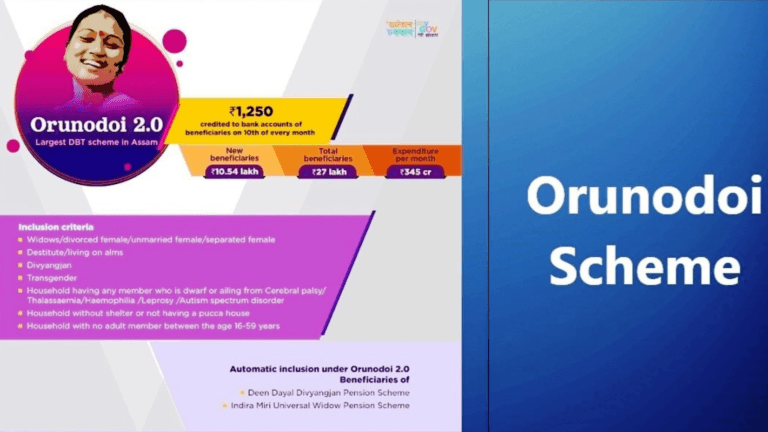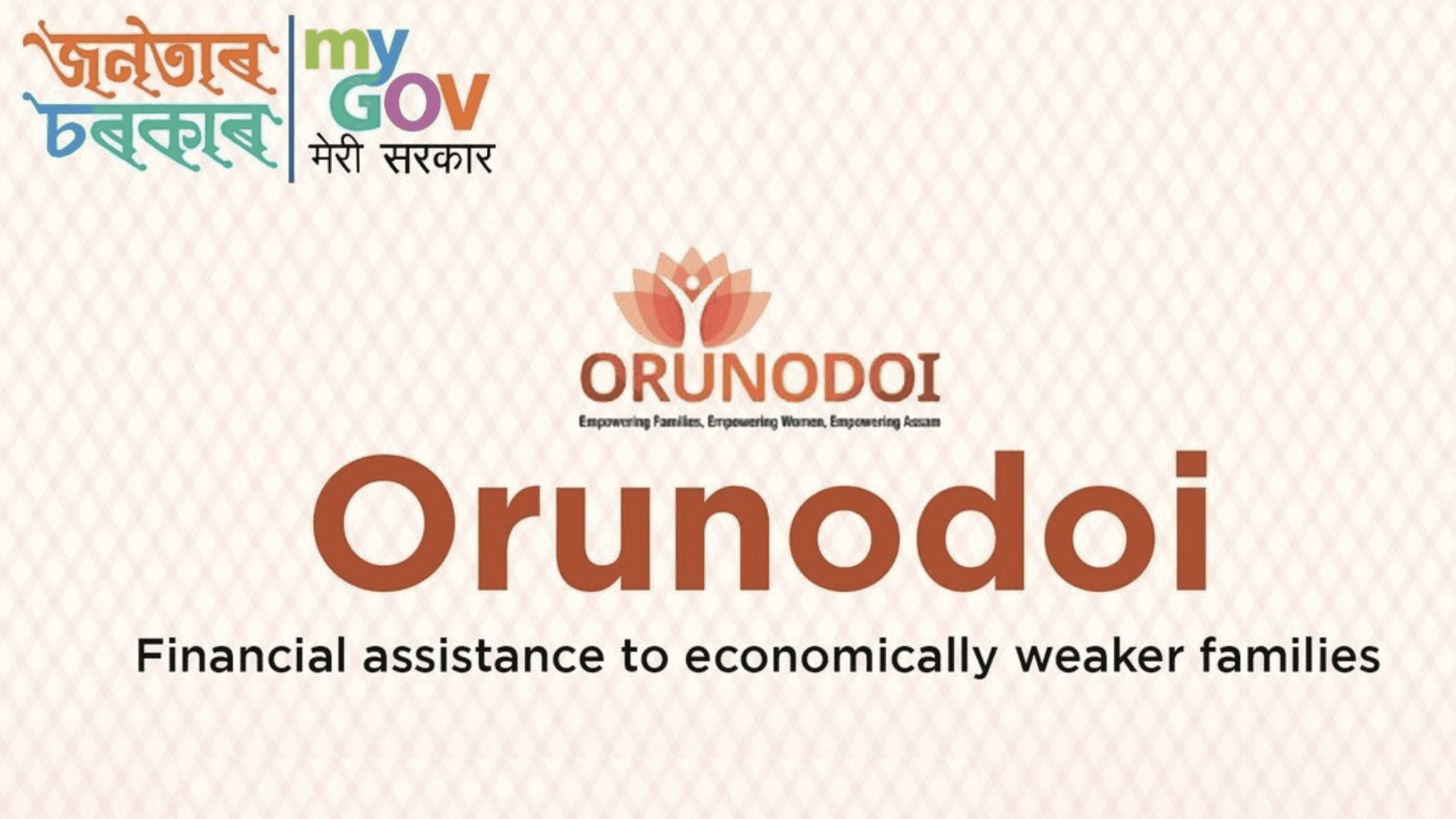
Overview of Assam Orunodoi 2.0 scheme:
Orunodoi 2.0 scheme is a scheme launched on 2nd Oct’2020 by the Government of Assam which aims to provide financial assistance to eligible beneficiaries for procuring various essential needs including health and nutritional items such as medicines, pulses, sugar fruits, etc. An amount of Rs 1250 per month per family will be provided through Direct Bank Transfer (DTB) to around 27.61 lakh families in the state. Under this scheme, out of Rs 1250, Rs.400 for procuring medicines, Rs 200 for 50% subsidy on 4 kgs of pulses, Rs 80 for 50% subsidy on 4 kgs of sugar, Rs 150 for purchasing fruits and vegetables, Rs 170 for essential goods and Rs 250 for electricity expenses.
The Orunodoi 2.0 scheme was launched on 2nd Oct’2020 by the Govt of Assam to provide monthly financial assistance to poor families. The Govt of Assam envisaged for more than 24 lakh poor household in the state.
Table of Contents:
- Objectives
- Eligibility criteria
- Priority criteria
- Exclusion criteria
- Benefits
- Selection process
- How to apply
- Documents required
- Objectives
2.0 FAQ
Objectives of Orunodoi 2.0 scheme:
Following are the objectives of Orunodoi 2.0 scheme:
- To provide financial assistance to the poor needy families.
- To improve the living standard of the beneficiaries by giving financial assistance for procurement of medicines and other essential goods.
- To try to reduce poverty rate in the state and bring happiness to the families.
- To provide financial assistance to acquire other essential goods too.
A brief description of the scheme is given below:
| Name of the scheme | Orunodoi 2.0 |
| Launched on | 2nd October,2020 |
| Implement by | Govt. of Assam |
| Category | Govt scheme |
| Purpose | To provide financial assistance to the poor family |
| Financial assistance | Rs 1250/- per month per family |
| Beneficiary | Women belonging to poor family |
| Mode of operation | Offline |
| website | https://www.orunodoi.in |
Break-up of the monthly financial assistance:
| Particulars | Amount allotted |
| Procurement of medicine | Rs 400 |
| 50% subsidy for 4 kgs of pulses | Rs 200 |
| 50% subsidy for 4 kgs of sugar | Rs 80 |
| Fruits and vegetables | Rs 150 |
| Essential goods | Rs 170 |
| Electricity expenses | Rs 250 |
| Total | Rs 1250 |
Eligibility criteria for Orunodoi 2.0 scheme:
Under this scheme, the applicants have to fulfil the following eligibility criteria.
The applicant should meet all the three criteria mentioned below.
- The applicant must be a permanent resident of Assam.
- The applicant should be presently residing in Assam.
- Any one of the following criteria:
- Composite household income of the applicant should be less than 2 lakh p.a.
Or
- Household having dwarf member or ailing from cerebral palsy/Thalassaemia/Haemophilia/Leprosy/Autism spectrum disorder.
Or
- Existing beneficiaries of Deen Dayal Divyangjan pension scheme and Indira Miri Universal Widow pension scheme.
Priority criteria for Orunodoi 2.0 scheme:
Priority will be given, in case there is a lower quota available than the number of applications.
- Having widows, divorced female, unmarried female above age of 45 years, separated female.
- “Specially-abled” member of the households.
- Destitute living on alms.
- Households having no shelter or not having a pucca house.
- Households having no adult members between the age of 16-59 years.
- Households headed by females and having no male adult member between the age of 16-59 years.
- Deserted women living in old age homes/institutions registered with the Government.
- Victims of human trafficking or rape of any age recorded in Government record.
Exclusion criteria Orunodoi 2.0 scheme:
Despite having eligibility criteria, there are some criteria considered as ineligible for Orunodoi 2.0 scheme. The following are the ineligibility criteria for Orunodoi 2.0 scheme.
- Households having former or present MPs/MLAs.
- Current members of Panchayati Raj institutions, Urban local bodies or autonomous councils, VCDCs,VDCs(in sixth schedules districts)
- Households having Doctors, Engineers, Lawyers, Chartered Accountant, Architects and Registered Government Contractors.
- Households having members of serving or having served as an employee or Officer in any Government ministry, department or in office or any central or state PSU, autonomous bodies, local Government bodies, cooperative societies partially or fully funded by Government.
- Households having any individual income-tax payee.
- Households which own more than 15 bighas of agricultural land/ 1 bigha or more residential land in rural area.
- Households having four wheelers motor vehicle including tractors.
- Households having air-conditioner.
Benefits of Orunodoi 2.0 scheme:
The Government of Assam launched the Orunodoi 2.0 scheme which aims to immensely help the poor families in the state. Under this scheme, the poor household will be benefitted in the following ways.
- Orunodoi 2.0 scheme provides Rs 1250/- per month each to 27.61 lakh families in Assam.
- Financial assistance to eligible beneficiaries of Rs 1250/- will support the poor families to meet their medical and nutritional needs.
- The amount will be sent by Direct Bank Transfer to the bank account of nominated woman of the family.
- Eligible beneficiaries will receive the amount on the tenth of every month..
Selection process of Orunodoi 2.0 scheme:
Orunodoi 2.0 scheme will choose the following selection process.
- The District Level Monitoring Committee will be in-charge-of completing the beneficiary list.
- The Village Council Development Committee, the Gaon Panchayat or Urban local authority shall conduct the preliminary selection.
- An undertaking cum checklist must be prepared by the Village Council Development Committee, the Gaon Panchayat and the Urban local Authority in accordance with the eligibility requirements.
- The checklist will be appended to Annexure A.
- The District Level Monitoring Committee will create the checklist according to LACs so that it can be presented to the District Level Monitoring Committee for prioritising and selection.
- District level committee then needed to order the applicant list.
- Now the committee will be in charge of ensuring that recipients submit a thorough application form and the details and other information are gathered.
- The approved final list is going to upload.
- The recipient information will be verified after uploading.
- It will correct any discrepancies in the details if there are any.
- The finance department will use the PMFS technique to transfer the funds into the beneficiary’s account once all necessary procedures have been completed.
- Every year, the recipient list is reviewed and additions and deletions are made as necessary.
- The finance department will keep a database with all the beneficiary information updated.
- It should be highlighted that if a candidate receives benefits from this programme despite being ineligible, they are responsible for paying back the money they got.
How to apply for Orunodoi 2.0 scheme:
The process to apply for Orunodoi 2.0 scheme is offline only. To get Orunodoi scheme benefits, the beneficiaries have to apply offline through respective Gaon Panchayat office. Following are the steps to follow for offline apply of Orunodoi 2.0 scheme.
- Collect Application Form from respective Gaon Panchayat.
- Fill up the Application Form.
- Attached the required documents such as Aadhar card, PAN card, Voter ID, Bank passbook along with the Orunodoi Form.
- The respective ward member will assist the entire application process.
- Submit the filled-up Application Form at respective Gaon panchayat office.
Documents for Orunodoi scheme:
The following documents are required for the Orunodoi 2.0 Scheme
- Aadhar card
- PAN card
- Voter card
- Bank passbook
- Income certificate
- Domicile certificate
- Passport size photographs
FAQ:
What is Orunodoi 2.0 scheme?
The Orunodoi 2.0 scheme is a scheme launched on 2nd October, 2020 by the Government of Assam to provide financial assistance monthly to support to the poor family.
How much financial assistance is provided by the scheme?
An amount of Rs 1250/- per month per family.

